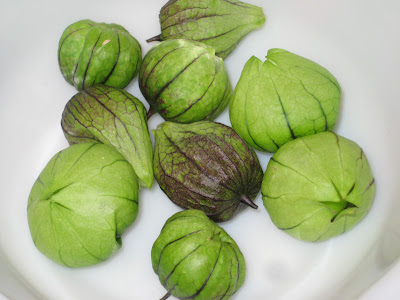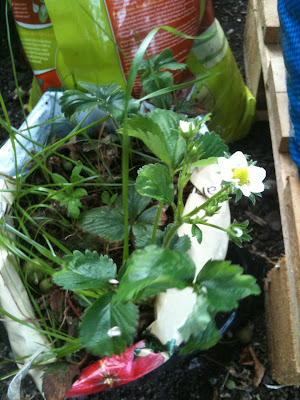I finally built the fourth raised bed at the allotment. I'm not being too strict with the crop rotation division, but I'm broadly trying to keep the four groups of crops separate: potatoes, root crops (onions, garlic), legumes (peas and beans), and brassicas ("green stuff" - kale, broccoli, cabbage, chard). Each type uses up different nutrients from the soil and develops similar diseases, so it's good in theory to move them about your plot every year. I don't think this is so crucial in a very small space, but it's a great excuse for tinkering and planning planting plans!
Ya tengo cuatro jardineras en la huerta. La teoria dice que se repartan las cosechas en cuatro grupos y se alterne cada ano para no sembrar lo mismo siempre en el mismo sitio - para no empobrecer el suelo demasiado (cada grupo necesita nutrientes distintos). Yo no creo que se note mucho en un terreno tan minimo, pero es una buena excusa para planificar las cosechas y entretenerme!
From front to back:
Bed 1: Potatoes. I earthed them up with some compost and gravel that I had left over; it's got a double purpose: covers the potato roots now, and when I dig it all up at the end it will help improve the soil.
 |
Jardinera primera:
La gravilla proteje las raices de las patatas del sol, y mejora la calidad de la tierra |
Bed 2: Onions, and a row of nasturtiums and calendula. The ground is covered by a mulch of the dry leaves from the jasmine I chopped from the shed...
 |
| Jardinera segunda: Cebollas |
Bed 3: dwarf peas (already climbing up their mini sticks), broad beans, and in between a plant of borage and a small square of leek seedlings
 |
| Jardinera tercera: Guisantes y habas (no en la foto) |
Bed 4: two rows of sprouting broccoli seedlings, one of red chard, one of Borlotti beans, and I'm ging to build a teepee for four runner bean plants. This is the one at the back with the taller frame of bamboo canes; birds love to munch of these leafy plants so I'm going to cover them with netting.
 |
General view of my allotment strip
|
La cuarta jardinera tiene: brecol, berzas, judias y frijoles. El soporte de canas de bambu es para poner una red por encima para que que los pajaros no se coman las hojas de estas plantas, que les encantan.
 |
| En la parte de atras tengo macetas sembradas con cebolletas y zanahorias |
Behind the trees, and in front of the flowers at the very back, I have at the moment a platform made with two pallets and lots of containers (the three blue things are Ikea bags) filled with compost. I sowed all the pots with carrots and spring onions, and the bigger bags are awaiting a courgette, a tomato and whatever else I run out of space for! I hope it is productive, but next year I want to build another raised bed in its placed, as containers need more frequent watering and I only go there at weekends. Plus, I think it will look better!











































